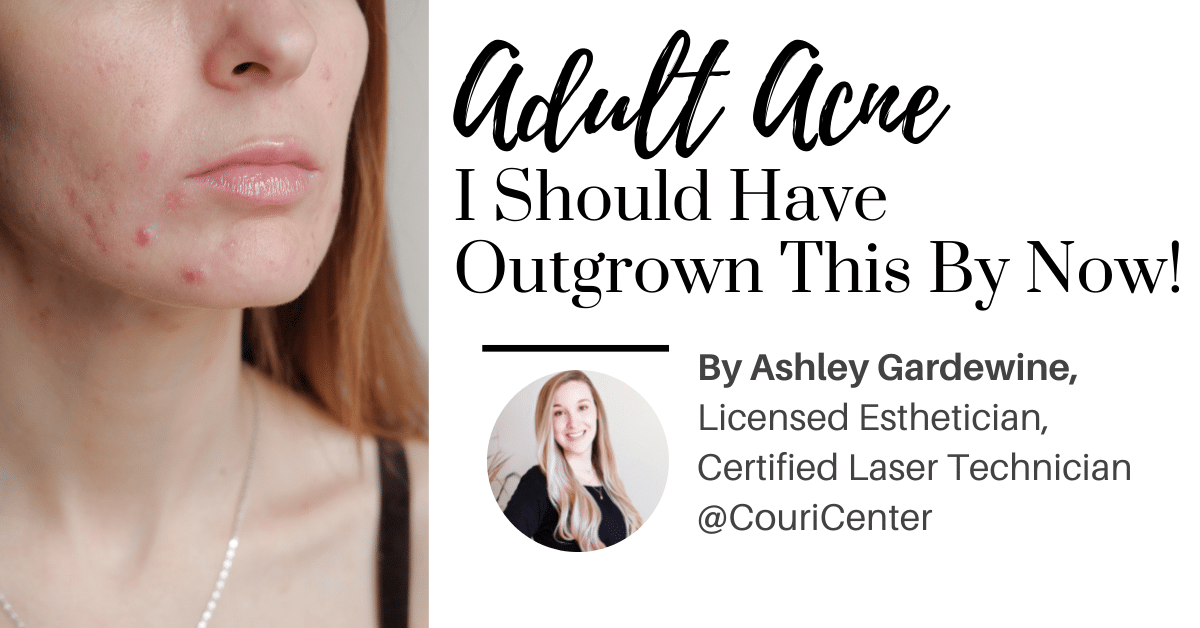
Struggling with adult acne can be a tedious and emotional issue. You wonder if others are taking you seriously at work when inside, you feel like a spotty teenager. Or, if your skin is bad enough, you cancel meetings altogether for fear of being looked at or judged. I’ve heard your struggles, and I am here to help.
While Acne is never easy to deal with, it can be especially traumatic as an adult. It wouldn’t be unusual in your 30s, 40s, and 50s to think, “I’m too old for this.” But the truth is that adult acne is more common than you might have thought.
The worst part about Acne – particularly as an adult – is that it not only affects your skin, possibly resulting in blemishes, scarring, or post-inflammatory hyperpigmentation, but it can also take a significant toll on your confidence. The good news is that there are options for controlling and diminishing the appearance of Acne.
While a consistent, thorough skincare routine can help prevent Acne, many factors contribute to acne breakouts aside from the products you do/don’t use on your skin. To fully understand the causes of adult acne and available treatment options, you should first identify the type of adult acne you are experiencing.
What are the common types of adult acne?
A comedone is the scientific name for a whitehead or a blackhead. These pesky skin blemishes pop up when the openings of hair follicles become clogged or blocked by excessive sebum, dead skin cells, or an overabundance of P. acne bacteria. If the comedone is open at the skin’s surface, the plug in the hair follicle appears as a blackhead, whereas closed comedones result in a slightly raised skin-colored bump or a whitehead. While comedones are some of the most common forms of adult acne, various inflammatory lesions may also appear.
Papules, or small raised bumps that indicate inflammation or infection in the hair follicle, may be red and tender, like pustules, or pimples, which are red, tender bumps with pus at their tips.
Nodules or cysts are large, solid, painful lumps beneath the skin’s surface caused by the buildup of secretions deep within hair follicles. Like nodules, cysts occur beneath the skin’s surface and result in pus-filled lumps that can ultimately result in scarring of the skin.
What Causes Acne?
Increased or excessive sebum production, an over-abundance of P. acne bacteria, and inflammation can cause Acne. These conditions are often caused by contact with greasy substances, and in some cases, cosmetics that are applied directly to the skin are all factors that may cause an acne breakout. Some other factors that may trigger or aggravate an existing case of acne are hormones, medications, stress, diet, and genetics.
After adolescence, hormones in women are heightened 2 to 7 days before a menstrual cycle, during pregnancy, or from oral contraceptives. When these hormone levels increase, sebaceous glands enlarge to create more sebum, an oily/waxy substance that can clog pores.
How should you treat adult acne?
Consider these skincare tips to help achieve clearer, healthy skin.
- Cleanse regularly with a product that’s appropriate for your skin type. Oily skin types can use a foaming cleanser that helps minimize the oil content on your skin, whereas dry skin types should stick to cream or oil-based cleansers.
- Moisturize. Just because your skin may be oily or prone to Acne doesn’t mean that it can’t also be dehydrated. When your skin becomes too dry, it responds by ramping up oil production, which can become trapped inside pores and lead to more Acne.
- Eat right. While it’s not true that eating greasy foods will translate to greasy skin, some foods can negatively affect your skin. Sugar and dairy are two of the most common culprits, so limiting these ingredients in your daily diet may help to clear your complexion (Journal of Clinical and Aesthetic Dermatology).
- Add in quality supplements. Fish oil is a great anti-inflammatory and helps alter sebum production; HOWEVER, only if it’s molecularly distilled or pharmaceutical grade. Unfortunately, many fish oil supplements are oxidized, which creates MORE inflammation. Therefore, I recommend Nordic Naturals ProOmega, which you can order online or find at the Couri Center.
- Schedule bi-weekly/monthly treatments with me. Very mild corrective peels boost the home care regimen along with extractions for existing Acne.
- Following chronic acne or persistent breakouts, some sufferers are left with dark scars. I recommend doing a series of 3-6 SkinPen® (microneedling) treatments to help even out your skin tone. By triggering your skin’s natural wound healing processes, SkinPen® Precision is able to tackle skincare issues and deliver fresh, remodeled skin without injecting any substances. Instead, the first FDA-Cleared microneedling device works with the skin to reveal your inner glow. Nothing added, nothing wasted — SkinPen’s Collagen Induction Therapy is the all-natural way to go.
Healing the skin is not a linear process. I always tell clients we will become best friends through their skin journey. I promise I’ll stand by your side every step of the way!
To healthy skin,
Ashley Gardewine, LE
